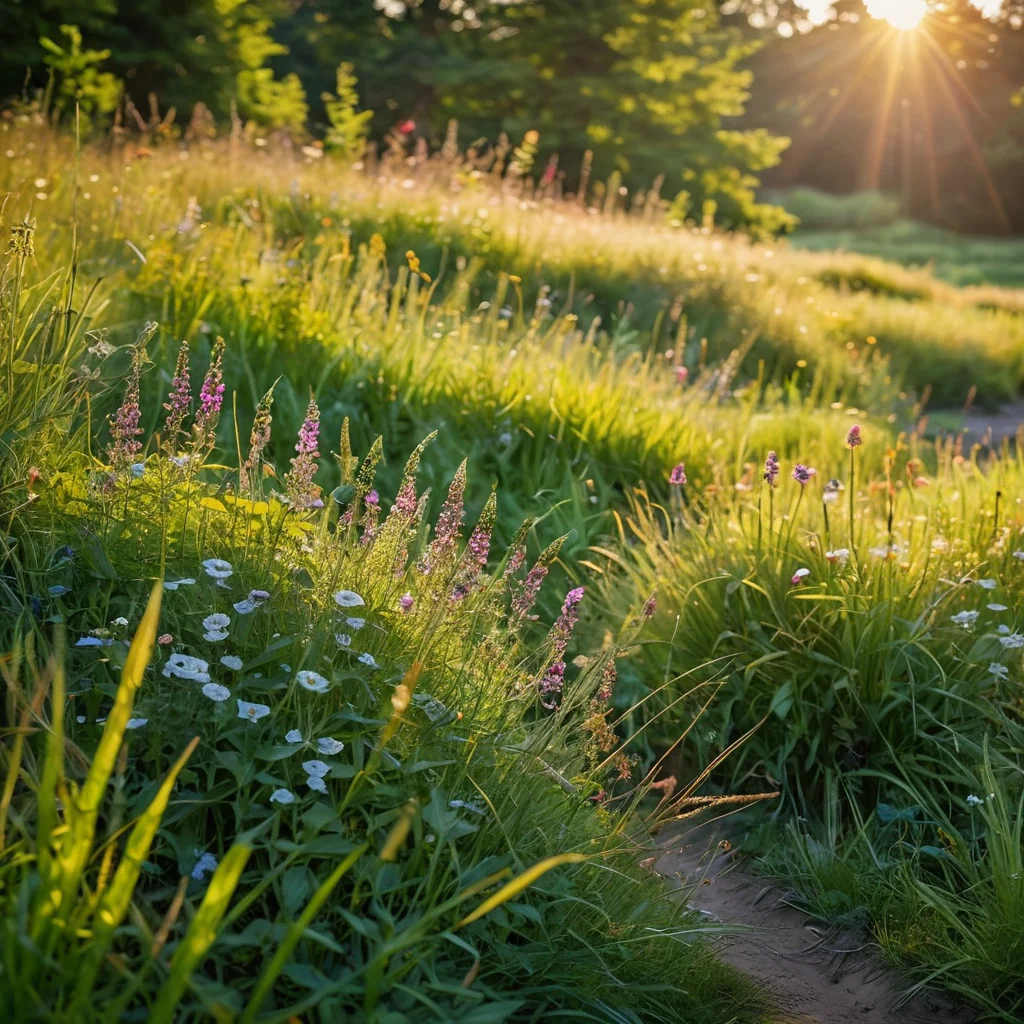Remember how as a child you ran barefoot through a meadow, with tiny wildflowers crunching underfoot, filling the air with a delicate aroma? This magical feeling of lightness, freedom, and unity with nature can be recreated right in your own garden, abandoning the usual emerald carpet in favor of something more alive, natural, and so familiar. Today we will talk about the Moorish lawn – a true celebration of color and aroma that will transform your dacha into a fairy-tale glade.
What is a Moorish Lawn and How Does it Differ from a Regular One?
At first glance, it might seem that a Moorish lawn is just an unkempt patch of grass overgrown with weeds and wildflowers. But this is far from the truth! In reality, it is a well-thought-out and specially created composition of low-growing cereal grasses and various flowering plants. Its main difference from a classic English lawn is its naturalness, diversity, and minimal maintenance. If a regular lawn requires regular mowing, perfect leveling, and fighting any “undesirable” plants, then a Moorish lawn, on the contrary, welcomes natural diversity.
Here are the key differences:
- Composition: A classic lawn is a mixture of predominantly one or two types of cereal grasses (e.g., fescue, fescue). A Moorish lawn, however, consists of grasses (usually making up about 80-90% of the mixture) and a large number of low-growing, nectar-rich flowers (10-20%).
- Maintenance: A regular lawn is mowed every week, or even more often. A Moorish lawn is mowed only 1-2 times per season, usually in late autumn, after the plants have finished blooming and the seeds have fallen to the ground. This allows the flowers to self-seed and delight you year after year.
- Appearance: An English lawn is a flat, uniform green field. A Moorish lawn is a colorful, vibrant picture that changes throughout the season, full of colors and aromas.
- Functionality: A regular lawn is more of a decorative element, a space for games or relaxation. A Moorish lawn is also an ecosystem that attracts pollinating insects (bees, butterflies), birds, and serves as a beautiful backdrop for photo sessions or simply meditative contemplation.
In essence, a Moorish lawn is an attempt to preserve a piece of wild nature, its beauty and harmony, on your plot, while receiving maximum aesthetic pleasure and minimum labor costs. It is the choice of those who are tired of the endless struggle for a perfect green carpet and want to see a real riot of flowers on their land.
Why Have a Moorish Lawn: Benefits and Aesthetics
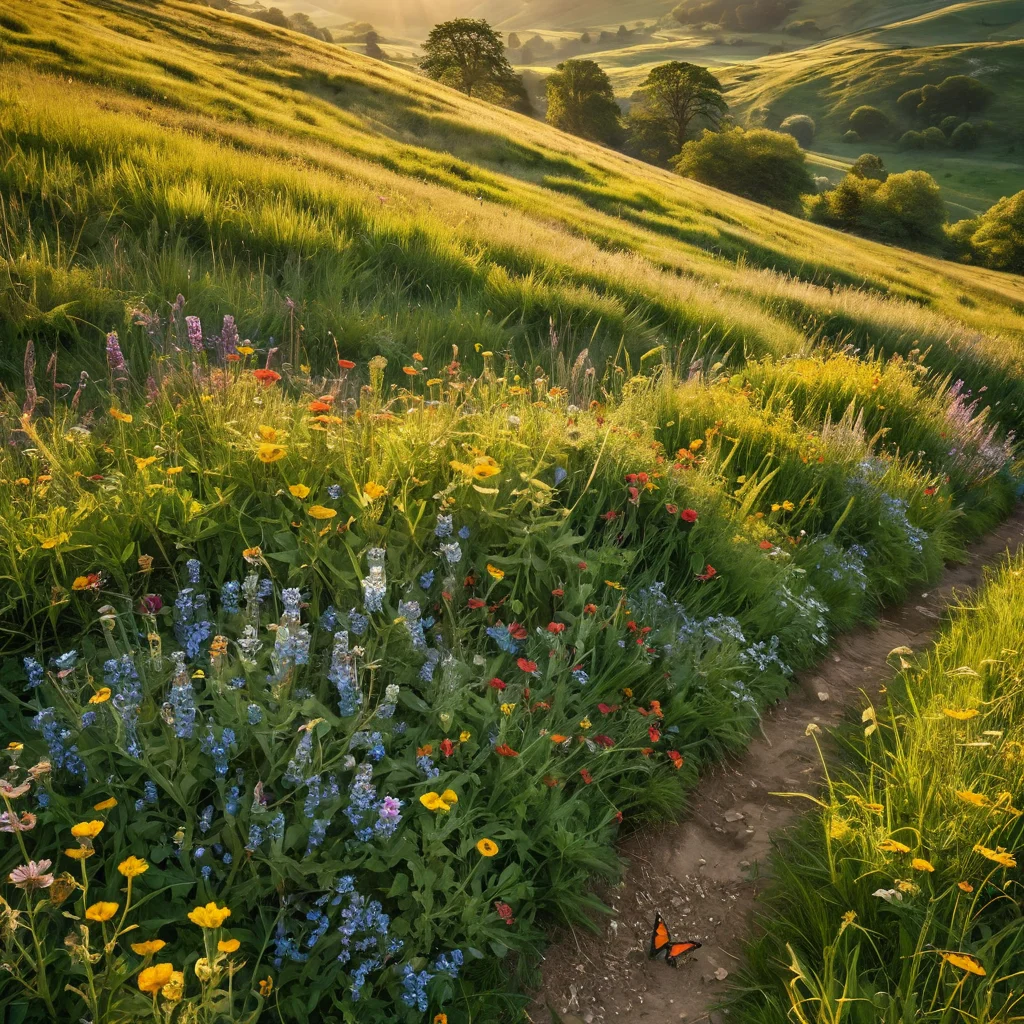
Deciding to create a Moorish lawn on your property is not just a trend, but a conscious choice in favor of beauty, naturalness, and environmental friendliness. This type of lawn opens up a world of benefits that both novice and experienced gardeners will appreciate.
Let’s break down the main advantages:
- Incredible Decorativeness: The main advantage of a Moorish lawn is its stunning appearance. Imagine a meadow dotted with bright flowers: blue cornflowers, red poppies, yellow daisies, white clovers, pink sweet peas… Every year it will be slightly different, but invariably picturesque. It is the ideal option for creating a romantic atmosphere, a secluded corner, or a bright accent in the garden.
- Minimal Maintenance: If you are not ready to spend your weekends on weekly mowing and weeding, a Moorish lawn is your ideal choice. It does not require frequent mowing, perfect leveling, or complex fertilization. One or two mowings per year and occasional watering during dry periods are sufficient. This is a real find for busy people or those who prefer to enjoy nature rather than work on it.
- Attracting Beneficial Insects: Flowering plants are a real magnet for bees, bumblebees, butterflies, and other pollinating insects. By creating a Moorish lawn, you not only decorate your property but also make an invaluable contribution to supporting the local ecosystem. And observing busy bees and fluttering butterflies is a real pleasure!
- Environmental Friendliness and Naturalness: A Moorish lawn is as close as possible to natural landscapes. It does not require the use of harsh chemicals to combat weeds or pests, making it completely safe for you, your children, and your pets.
- Affordability: Unlike traditional lawns, which require expensive seeds, regular fertilization, and special equipment, a Moorish lawn can be created using relatively inexpensive mixtures of grasses and flowers. Moreover, it can self-seed and renew itself, reducing your future costs.
- Wide Creative Opportunities: You can choose the composition of the mixture yourself, based on your preferences for color scheme, plant height, and blooming time. This allows you to create a truly unique corner that reflects your style and vision.
A Moorish lawn is not just a beautiful picture. It is a philosophy of life that allows you to enjoy the harmony of nature while minimizing labor costs. It brings bright colors, delicate aromas, and a sense of peace to your life, which only unity with nature can provide.
Plant Varieties for a Moorish Lawn: Choosing Grasses and Flowers
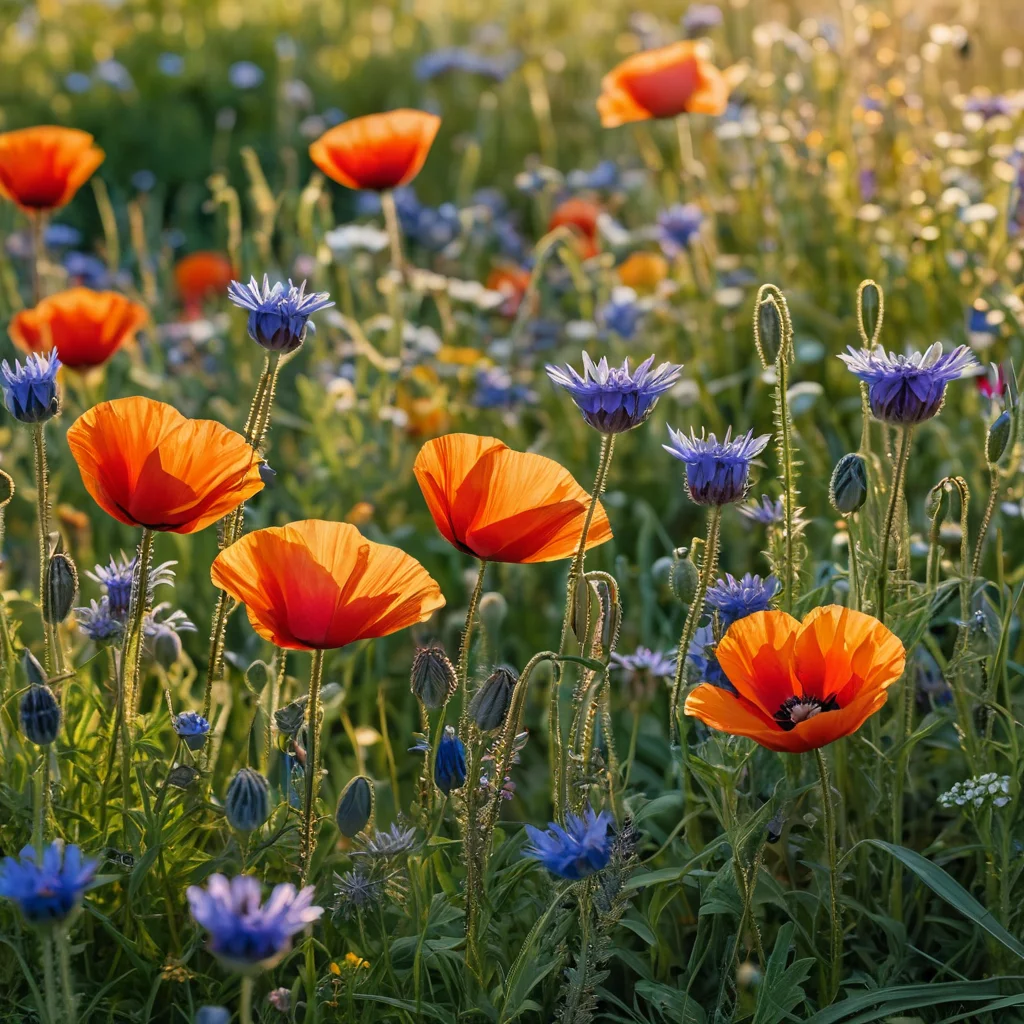
Creating a beautiful and harmonious Moorish lawn begins with the right selection of plants. It is important to maintain a balance between cereal grasses, which will form the base, and bright flowers, which will give it a unique charm. Remember that all components of the mixture should be low-growing, drought-tolerant, and non-aggressive.
Cereal Grasses – The Foundation of Your Lawn
Grasses in a Moorish lawn act as a “background” for flowers, creating volume and texture. They should be unpretentious and grow slowly after mowing.
- Red Fescue (Festuca rubra): One of the most popular grasses for Moorish lawns. It is drought-tolerant, shade-tolerant, and forms a dense but not aggressive turf. There are many varieties; choose low-growing ones.
- Creeping Bentgrass (Agrostis stolonifera): Forms a very dense and low carpet, but can be more demanding of moisture than fescue. It pairs well with low flowers.
- Low-growing varieties of Kentucky Bluegrass (Poa pratensis): Some varieties of bluegrass are characterized by slow growth and good drought tolerance. It gives the lawn a velvety texture.
- Timothy-grass (Phleum pratense): Used in the mixture in small quantities, as it can grow quite tall. It is better to choose special low-growing varieties.
- Perennial Ryegrass (Lolium perenne): Germinates quickly and forms a dense cover, but can be less durable and more demanding of care than other grasses. Use it in small quantities or avoid it if you aim for minimal maintenance.
Tip: For a Moorish lawn, it is best to choose grass mixtures specifically designed for it, or create your own, focusing on low growth, drought tolerance, and slow growth. The classic ratio is 80-90% grasses and 10-20% flowers.
Annual and Perennial Flowers – Bright Accents
Flowers are the soul of a Moorish lawn. They should be low-growing, diverse in shape and color, preferably nectar-rich and unpretentious.
- Cornflower (Centaurea cyanus): A classic for Moorish lawns. Bright blue flowers look great against a green background.
- Common Poppy (Papaver rhoeas): The fiery red, delicate petals of the poppy create a unique color.
- Chamomile (Matricaria chamomilla): White “eyes” of chamomile add lightness and elegance.
- White Clover (Trifolium repens): Not only decorates the lawn but also enriches the soil with nitrogen. Its low-growing varieties are ideal.
- Pot Marigold (Calendula officinalis): Bright orange flowers delight the eye from early summer to autumn.
- Cosmos (Cosmos): Various varieties of cosmos, especially low-growing ones, will add diversity and tenderness.
- Forget-me-not (Myosotis): Delicate blue flowers create a charming carpet.
- Sweet Pea (Lathyrus odoratus): Its fragrant flowers will add sophistication, but it is important to choose low-growing varieties.
- California Poppy (Eschscholzia californica): Bright orange or yellow “cups” of flowers.
- Phacelia (Phacelia tanacetifolia): An excellent nectar plant with fragrant purple flowers, attracts insects.
- Baby’s Breath (Gypsophila paniculata): Delicate white cloud-like flowers.
- Yarrow (Achillea millefolium): Various varieties with flowers from white to pink and red.
- Bellflower (Campanula): Low-growing varieties with blue, purple, or white flowers.
- Alfalfa (Medicago sativa): Enriches the soil well.
What to consider when choosing:
- Plant Height: All components should not exceed 20-30 cm in height.
- Blooming Time: It is desirable for the plants to bloom at different times, ensuring continuous flowering from spring to autumn.
- Environmental Resistance: Choose plants that are resistant to drought, sun, and poor soils, as a Moorish lawn does not require intensive care.
- Nectar Production: Prefer flowers that attract bees and butterflies.
- Plant Type: It is best to use annuals and non-aggressive perennials that self-seed easily but do not displace grasses.
Ready-made mixes: Today, there are many ready-made mixes for Moorish lawns available for sale. They are already balanced in composition and selected according to all requirements. This is the easiest option for beginners. However, if you want to create something special, you can try to create your own unique mix.
How to Prepare the Soil for a Moorish Lawn: From A to Z
Soil preparation is perhaps the most crucial stage in creating any lawn, and a Moorish lawn is no exception. Although it is less demanding of perfection than a regular one, without proper soil preparation, your floral dreams may not come true.
Step 1: Clearing the Area
First of all, it is necessary to completely clear the area chosen for the lawn of construction debris, old grass, stones, and, of course, weeds. Pay special attention to perennial weeds with developed root systems (couch grass, sow thistle, ground elder). They must be removed as thoroughly as possible so that they cannot sprout again.
- Manual Weeding: The most labor-intensive, but also the most reliable method. Carefully dig out weed roots.
- Broad-spectrum Herbicides: If the area is heavily overgrown, herbicides can be used. After application, it is best to leave the area for some time for the product to take effect and destroy the weed root system. After that, be sure to dig up the soil.
- Mulching: You can cover the area with black non-woven material or cardboard for several months. Under the influence of heat and lack of light, weeds will die.
Step 2: Assessing and Improving Soil Structure
A Moorish lawn prefers light, loose soils. Heavy clay or overly sandy soils require improvement.
- For Clay Soils: Add coarse sand, peat, compost, or humus. This will make the soil more air- and water-permeable.
- For Sandy Soils: Add clay soil, compost, humus, peat. This will help retain moisture and nutrients.
- Acidity: Most grasses and flowers for a Moorish lawn prefer neutral or slightly acidic soil (pH 5.5-7.0). If the soil is too acidic, add dolomite flour or lime. If it is alkaline, you can add peat or coniferous litter.
Step 3: Digging and Leveling
After clearing and improving the soil, proceed with digging. The digging depth should be about 20-25 cm. During digging, also remove any remaining weed roots and stones. After digging, the area needs to be carefully leveled:
- Rakes: Use garden rakes to break up large clumps of soil and create a level surface.
- Roller (optional): For better soil compaction, a garden roller can be used. If you don’t have one, you can walk over the area, pressing down firmly with each step.
Step 4: Fertilizing (Carefully!)
A Moorish lawn does not require abundant fertilization, especially nitrogen, which stimulates vigorous growth of greenery at the expense of flowers. It is best to use complex mineral fertilizers with low nitrogen content and a predominance of phosphorus and potassium. They promote root development and abundant flowering.
- During Preparation: You can add a little compost or humus (2-3 kg per sq.m.) to enrich the soil with organic matter.
- Mineral Fertilizers: Use specialized lawn fertilizers marked “for flowering lawns” or with reduced nitrogen content. Apply them according to the instructions.
Important: Do not use fresh manure! It can “burn” the roots of young plants and stimulate weed growth.
Step 5: Final Loosening
Just before sowing, go over the area with a rake again to loosen the top layer of soil (2-3 cm). This will create ideal conditions for seed germination.
Proper soil preparation is the key to ensuring that your Moorish lawn is not only beautiful but also resistant to external conditions, delighting you with lush flowering for many years. Don’t spare time on this stage, and the result will surely please you!
Step-by-Step Guide: How to Sow a Moorish Lawn Yourself
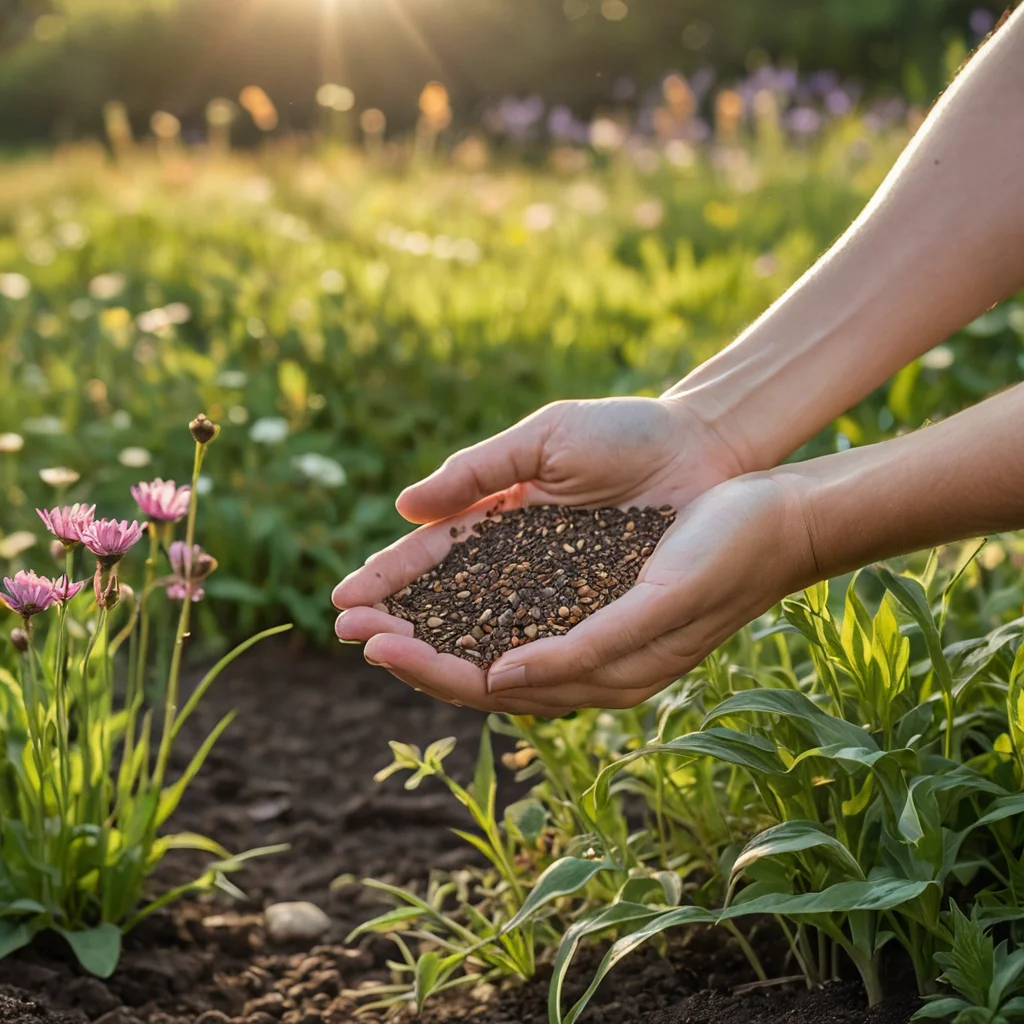
So, the soil is prepared, the seeds are chosen – it’s time to create magic! Sowing a Moorish lawn is not a difficult process, but it requires care and adherence to certain rules. By following this step-by-step guide, you can create your own blooming paradise.
Best Time to Sow:
The ideal time for sowing is early spring (April-May), when the soil has already warmed up, but has not yet dried out, and there is no threat of severe frosts. Autumn sowing is also possible (late August – September), but spring sowing generally yields better results.
Step 1: Seed Preparation
Flower and grass seeds often have different sizes and weights, so they can settle unevenly in the mixture. To ensure even distribution, it is recommended to:
- Mixing: Thoroughly mix the seeds in a large container.
- Mixing with Sand: For even more uniform sowing, you can mix the seed mixture with dry coarse sand in a ratio of 1:5 or 1:10 (1 part seeds to 5-10 parts sand). Sand acts as a filler and allows you to see where seeds have already been sown, avoiding omissions.
Step 2: Sowing Seeds
There are two main methods of sowing:
Method 1: Hand Sowing
- Even Distribution: Take a small amount of the prepared seed mixture (or mixture with sand) in your hand and scatter it evenly over the surface of the prepared soil. Try to do this in circular motions to cover the entire area.
- Repeat Sowing: For greater confidence, you can sow in two stages: first sow half of the mixture, moving in one direction (e.g., along the plot), and then the remaining half, moving perpendicularly (across the plot).
- Sowing Rate: Carefully read the instructions on the seed packet. The sowing rate is usually 2-5 grams per square meter. Do not overdo it; too dense sowing can lead to competition between plants for light and nutrients.
Method 2: Using a Seeder
- Hand Seeder: If you have a large area, you can use a hand seeder. Adjust it according to the instructions for even distribution of small seeds.
- Mechanical Seeders: There are also more complex mechanical seeders that can provide very precise distribution.
Step 3: Covering the Seeds
A Moorish lawn does not like deep seed covering. Most flower and grass seeds need light to germinate.
- Rolling: After sowing, gently roll the area with a garden roller or simply walk over it (without shoes if the soil is still soft). This will ensure good contact between the seeds and the soil.
- Light Covering (optional): Some gardeners prefer to cover the seeds with a very thin layer (no more than 0.5 cm) of light soil or peat, especially if strong winds or rain are expected. However, often, simple rolling is sufficient.
- Don’t Overdo It: The main thing is not to bury the seeds too deep. Many small flower seeds do not require covering at all.
Step 4: Watering
Immediately after sowing and rolling, the first watering should be done. Do this very carefully to avoid washing away the seeds:
- Fine Spray: Use a watering can with a fine sieve or a garden sprinkler in “rain” mode.
- Moderate Watering: The soil should become moist, but not turn into a swamp.
Step 5: Post-Sowing Care
For the first 2-3 weeks, while the seeds are germinating and the plants are rooting, keep the soil moist. Water regularly, but do not allow it to dry out or become waterlogged.
- First Sprouts: You will see the first sprouts in 1-3 weeks, depending on temperature and humidity.
- First Mowing: The first mowing is done when the plants reach a height of 8-10 cm. Do not cut more than 1/3 of the height. The cut plants can be left in place; they will serve as a natural mulch layer.
Creating a Moorish lawn yourself is an engaging process that brings immense satisfaction. Follow these simple steps, and soon your plot will transform into a real blooming meadow!
Moorish Lawn Care: Mowing, Watering, and Fertilizing
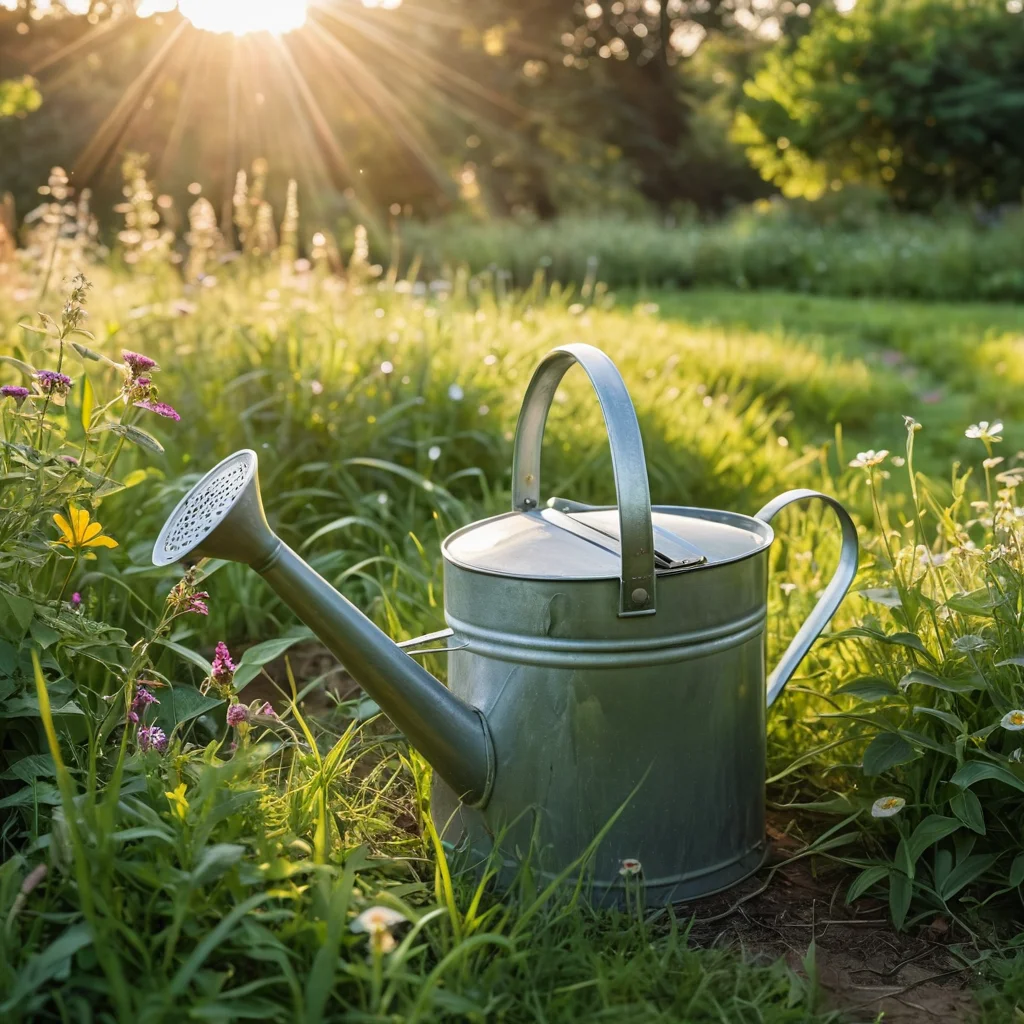
The main advantage of a Moorish lawn is its minimal care requirements. It is a real find for those who want to enjoy beauty without spending a lot of time and effort on it. However, to keep your blooming carpet pleasing to the eye, following a few simple rules is still necessary.
Mowing: Everything in Its Time
Unlike a traditional lawn, which requires frequent mowing, a Moorish lawn is mowed only 1-2 times a year. This is a key factor that allows flowers to bloom and reproduce by seed.
- First Mowing: Done when plants reach a height of 8-10 cm. Cut no more than 1/3 of the height. If possible, leave the cut grass on the lawn – it will serve as mulch and a source of nutrients.
- Main Mowing: This is the most important mowing, done in late autumn (October-November), after the plants have finished blooming and the seeds have fallen to the ground. The mowing height is usually 5-8 cm. The purpose of this mowing is to remove spent greenery and prepare the lawn for winter.
- Mowing Frequency: In most cases, one autumn mowing is sufficient. If the lawn becomes too dense or individual grasses start to aggressively dominate, a light summer mowing in June-July may be necessary, but do it carefully to avoid damaging the flowering plants.
- Mowing Height: Do not mow too short! A Moorish lawn does not like being cut “to the ground.” Leave sufficient height so that the plants can recover and continue to bloom.
- Equipment: A regular lawnmower is suitable for mowing. If it has a mulching function, that will be a big plus.
Watering: Moderation is Key
A Moorish lawn, due to its composition, is quite drought-tolerant. Most grasses and flowers in the mixture are adapted to natural conditions and can get by with natural rainfall.
- Young Lawn: For the first 2-3 weeks after sowing, the soil should be consistently moderately moist. Water regularly, but with a fine spray to avoid washing away seeds.
- Mature Lawn: During the period of active growth and flowering, especially in hot and dry weather, watering may be necessary. Water thoroughly but not too often. It is better to water the soil well once than to slightly moisten the top layer every day.
- Best Time to Water: Early morning or late evening, when the sun is not too active. This will help avoid rapid moisture evaporation and leaf scorch.
- Signs of Water Shortage: Wilting leaves, loss of flower brightness.
Fertilizing: Minimum for Maximum Benefit
Excessive amounts of fertilizer, especially nitrogen-based ones, are the main enemy of a Moorish lawn. Nitrogen stimulates the growth of green mass at the expense of flowering and can also contribute to weed growth.
- Organic Fertilizers: If you added compost or humus when preparing the soil, this may be sufficient for several years.
- Mineral Fertilizers: If you feel the lawn has become weak and flowering is sparse, you can fertilize with complex mineral fertilizers with low nitrogen (N) and increased phosphorus (P) and potassium (K) content. Such fertilizers promote flowering and strengthen the root system.
- Fertilizing Frequency: Usually, one fertilization per year in spring, before active growth begins, is sufficient.
- Application Method: Scatter the fertilizer evenly over the lawn surface and gently rake it in, then water.
Additional Care Tips:
- Weeding (as needed): If aggressive weeds appear that are crowding out the flowers, they can be carefully removed by hand.
- Aeration: Once every 1-2 years in spring, you can aerate the lawn – poke holes in the turf with a fork or a special aerator. This will improve the access of air and moisture to the roots.
- Moss Control: If moss appears on the lawn, it may indicate overly acidic soil or insufficient sunlight. You can add lime or improve drainage.
Believe it or not, caring for a Moorish lawn is more of a pleasant addition to its beauty than hard work. The main thing is to remember its natural character and not try to turn it into a perfect English carpet.
Common Mistakes When Creating and Caring for a Moorish Lawn
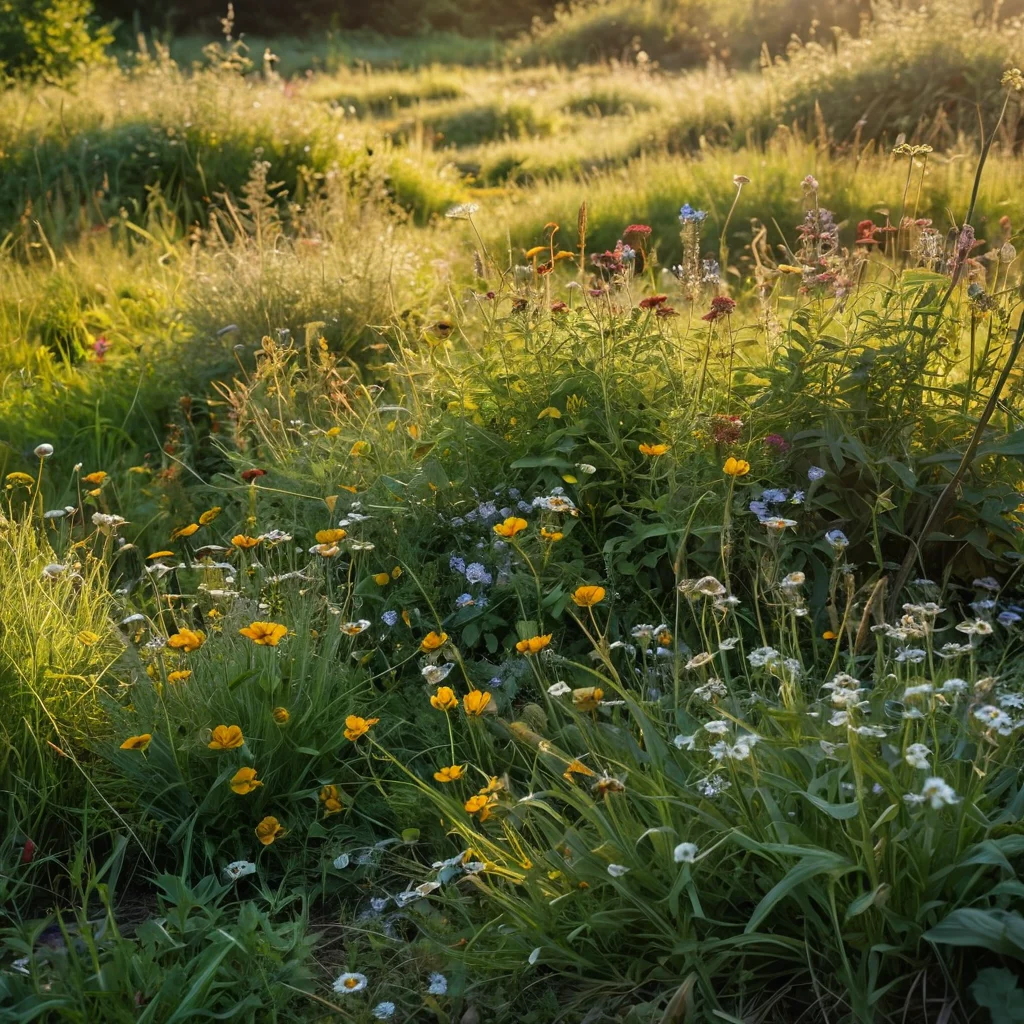
Even seemingly simple tasks can hide pitfalls. Creating a Moorish lawn is no exception. To ensure your blooming meadow delights the eye rather than causes disappointment, let’s look at the most common mistakes to avoid.
Mistakes in Soil Preparation:
- Insufficient Weed Removal: This is perhaps the most fatal mistake. If perennial weeds with strong root systems (couch grass, sow thistle, ground elder) are not removed before sowing, they will quickly overwhelm the delicate flowers and grasses, turning your lawn back into a weed patch.
- Using Fresh Manure: As I mentioned, fresh manure can “burn” young roots and stimulate weed growth. The soil should be fertilized with humus or compost, but without aggressive organic matter.
- Soil Too Compact or Too Loose: Clayey, compacted soils hinder drainage and air circulation to the roots. Sandy soils lose moisture and nutrients too quickly. It is important to achieve a light, loose structure.
- Not Leveling the Area: Unevenness in the plot will lead to water stagnation in low-lying areas and the soil drying out on elevated spots. This will create uneven growing conditions for the plants.
Mistakes During Sowing:
- Sowing Seeds Too Deep: Seeds of most flowers and grasses for a Moorish lawn need light to germinate. If they are buried too deep, they simply won’t sprout.
- Uneven Sowing: Overly dense areas will compete with each other, and bare patches will leave room for weeds. It is important to achieve even seed distribution.
- Ignoring Sowing Rate Instructions: The desire to have a “denser” lawn can lead to disappointment. Excessively dense sowing weakens plants and makes them more vulnerable.
- Sowing at the Wrong Time: Sowing too early can lead to seedlings dying from frost, while sowing too late means the plants won’t have time to strengthen before the heat or cold sets in.
Mistakes in Care:
- Mowing Too Frequently: This is the main mistake that turns a Moorish lawn back into a regular one. Flowers are simply not given a chance to bloom and produce seeds.
- Mowing Too Short: Cutting the lawn “to the ground” deprives plants of a chance to recover and bloom, and also damages the root system.
- Over-reliance on Nitrogen Fertilizers: This will lead to vigorous growth of greenery and suppression of flowers. A Moorish lawn should be not so much green as colorful.
- Excessive or Insufficient Watering: A young lawn requires constant moisture, while a mature one needs moderate watering. Drying out or constant “swampiness” is detrimental to plants.
- Ignoring Weeds: Despite minimal care, some aggressive weeds may still appear. They need to be removed before they take over the area.
- Trying to Make it an Ideal English Lawn: Remember that a Moorish lawn is about naturalness and diversity, not about perfect evenness and uniformity.
By avoiding these common mistakes, you can create a truly magical Moorish lawn that will delight you with its beauty and naturalness for many years to come.
Moorish Lawn in Landscape Design: Ideas and Inspiration
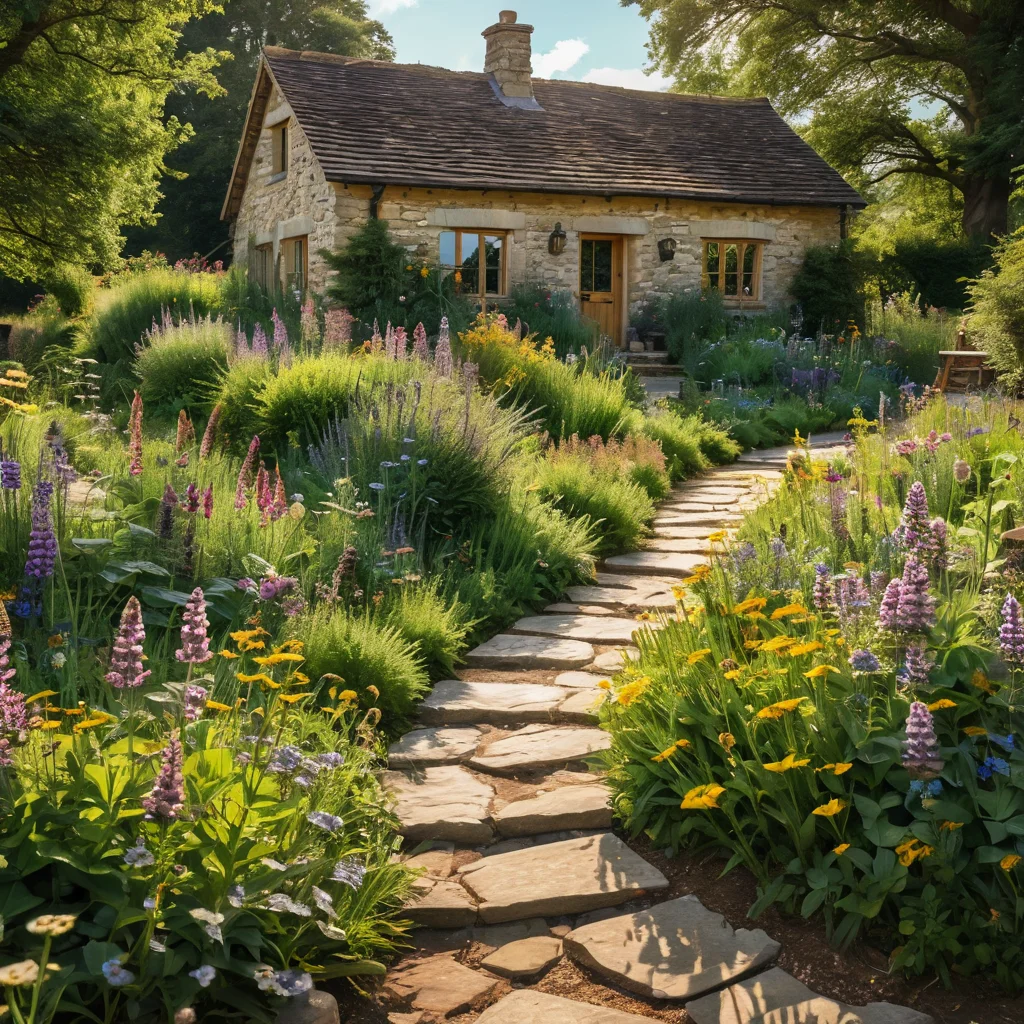
A Moorish lawn is not just an individual element, but a powerful tool in the hands of a landscape designer (and, of course, a passionate gardener!). It can transform any plot, giving it a special charm, romance, and naturalness. Let’s see how this “blooming glade” can be used in your garden.
1. Rock Gardens and Alpine Gardens
Idea: To create the feeling of a natural meadow spread among stones. The flowers of a Moorish lawn harmonize perfectly with natural stone, giving the composition lightness and picturesque beauty.
- Implementation: Part of a slope or a flat area can be planted with a Moorish lawn mixture, and large boulders can be placed among the stones. Tall grasses and bright flowers will create a natural contrast with the texture of the stone.
- Advantage: Such a lawn grows well on slopes where a regular lawn would be difficult to lay, and requires minimal maintenance.
2. Relaxation Zones and Secluded Corners
Idea: To create a blooming carpet around a gazebo, bench, or simply a secluded corner that will beckon you to relax and enjoy nature.
- Implementation: Plant a small area around the relaxation zone with a Moorish lawn. Place garden furniture here, perhaps a small pond or a decorative lantern. The blooming lawn will become a beautiful natural “carpet.”
- Advantage: This creates a sense of harmony with nature, is relaxing, and provides pleasant aromas.
3. Designing Borders and Paths
Idea: To use a Moorish lawn to frame garden paths, creating smooth transitions between different areas of the plot.
- Implementation: Sow a Moorish lawn mixture on both sides of the paths or around flowerbeds. It will create a soft, natural border that will change throughout the season.
- Advantage: Such a “border” does not require neat trimming like a hedge and gives the garden a freer, more natural look.
4. Filling Empty Areas
Idea: To transform unused or difficult-to-manage areas (e.g., under trees, on slopes) into picturesque blooming meadows.
- Implementation: Simply sow a Moorish lawn mixture in these areas. It is unpretentious and can grow where regular grass would wither.
- Advantage: This is a simple and budget-friendly way to improve “inconvenient” areas, turning them into decorative elements.
5. Creating “Wild” Corners
Idea: To recreate a corner of wild nature where not only flowers but also pollinating insects and birds will feel comfortable.
- Implementation: Designate a more remote part of the plot for a Moorish lawn. Add a few wild shrubs or tall grasses. This will create a natural habitat for many species.
- Advantage: Such a corner will be a real haven for local fauna and a source of inspiration for you.
6. Contrast with Formal Plantings
Idea: To use a Moorish lawn to create a contrast with geometrically regular flowerbeds, trimmed shrubs, or strict forms.
- Implementation: Sow a Moorish lawn in the open spaces around the formal elements of the garden. Its naturalness and riot of colors will emphasize the orderliness of other areas.
- Advantage: Such a contrast gives the garden depth, dynamism, and makes it more interesting to perceive.
A Few Tips for Integration:
- Combining with Perennials: A Moorish lawn can be complemented by unpretentious perennials that bloom at different times of the year, ensuring continuous flowering.
- Seasonality: Remember that the appearance of a Moorish lawn changes throughout the season. Plan its location with this in mind.
- Scale: A Moorish lawn looks great in both large and small plots. The main thing is to choose the right proportions and combination with other elements.
A Moorish lawn is more than just a way to decorate a plot. It is an opportunity to create a living, breathing organism in your garden, full of colors, aromas, and sounds of nature. Experiment, get inspired, and create your own unique fairy tale!
